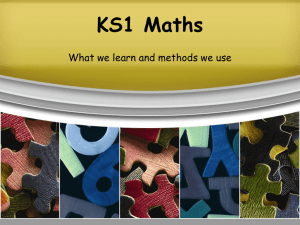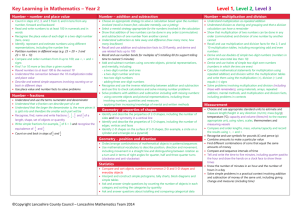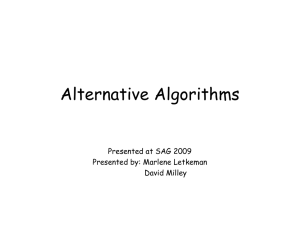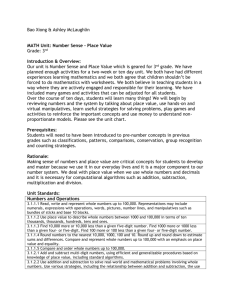Parent*s Guide to Supporting Maths in the New National Curriculum
advertisement
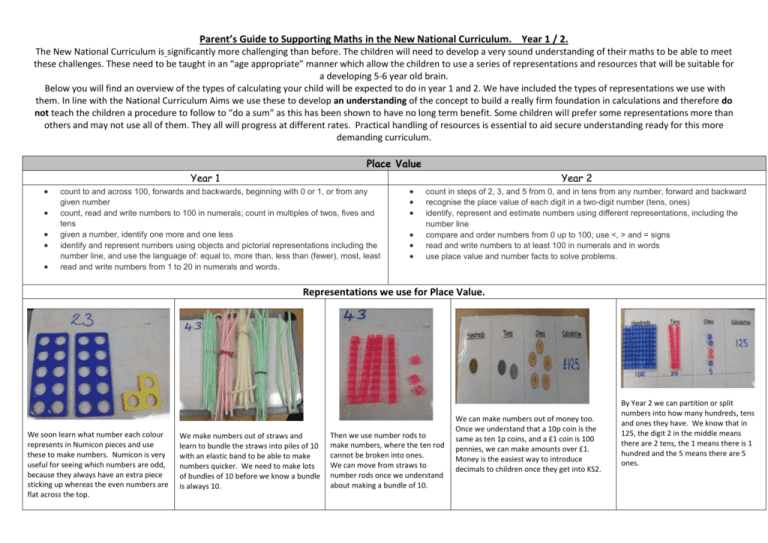
Parent’s Guide to Supporting Maths in the New National Curriculum. Year 1 / 2. The New National Curriculum is significantly more challenging than before. The children will need to develop a very sound understanding of their maths to be able to meet these challenges. These need to be taught in an “age appropriate” manner which allow the children to use a series of representations and resources that will be suitable for a developing 5-6 year old brain. Below you will find an overview of the types of calculating your child will be expected to do in year 1 and 2. We have included the types of representations we use with them. In line with the National Curriculum Aims we use these to develop an understanding of the concept to build a really firm foundation in calculations and therefore do not teach the children a procedure to follow to “do a sum” as this has been shown to have no long term benefit. Some children will prefer some representations more than others and may not use all of them. They all will progress at different rates. Practical handling of resources is essential to aid secure understanding ready for this more demanding curriculum. Place Value Year 1 Year 2 count to and across 100, forwards and backwards, beginning with 0 or 1, or from any given number count, read and write numbers to 100 in numerals; count in multiples of twos, fives and tens given a number, identify one more and one less identify and represent numbers using objects and pictorial representations including the number line, and use the language of: equal to, more than, less than (fewer), most, least read and write numbers from 1 to 20 in numerals and words . count in steps of 2, 3, and 5 from 0, and in tens from any number, forward and backward recognise the place value of each digit in a two-digit number (tens, ones) identify, represent and estimate numbers using different representations, including the number line compare and order numbers from 0 up to 100; use <, > and = signs read and write numbers to at least 100 in numerals and in words use place value and number facts to solve problems. Representations we use for Place Value. We soon learn what number each colour represents in Numicon pieces and use these to make numbers. Numicon is very useful for seeing which numbers are odd, because they always have an extra piece sticking up whereas the even numbers are flat across the top. We make numbers out of straws and learn to bundle the straws into piles of 10 with an elastic band to be able to make numbers quicker. We need to make lots of bundles of 10 before we know a bundle is always 10. Then we use number rods to make numbers, where the ten rod cannot be broken into ones. We can move from straws to number rods once we understand about making a bundle of 10. We can make numbers out of money too. Once we understand that a 10p coin is the same as ten 1p coins, and a £1 coin is 100 pennies, we can make amounts over £1. Money is the easiest way to introduce decimals to children once they get into KS2. By Year 2 we can partition or split numbers into how many hundreds, tens and ones they have. We know that in 125, the digit 2 in the middle means there are 2 tens, the 1 means there is 1 hundred and the 5 means there are 5 ones. Addition and Subtraction Year 1 Year 2 read, write and interpret mathematical statements involving addition (+), subtraction (–) and equals (=) signs represent and use number bonds and related subtraction facts within 20 add and subtract one-digit and two-digit numbers to 20, including zero solve one-step problems that involve addition and subtraction, using concrete objects and pictorial representations, and missing number problems such as 7 = ☐ – 9. solve problems with addition and subtraction: o using concrete objects and pictorial representations, including those involving numbers, quantities and measures o applying their increasing knowledge of mental and written methods recall and use addition and subtraction facts to 20 fluently, and derive and use related facts up to 100 add and subtract numbers using concrete objects, pictorial representations, and mentally, including: a two-digit number and ones, a two-digit number and tens, two two-digit numbers, adding three one-digit numbers show that addition of two numbers can be done in any order (commutative) and subtraction of one number from another cannot recognise and use the inverse relationship between addition and subtraction and use this to check calculations and solve missing number problems. Representations we use for addition. We start by using objects to combine two groups to add. We start by having to count all of them to find the total, before we realise we can count on from the biggest number. We can use the Numicon shapes to find the answer which saves us having to count objects. We can use a number line or a ruler to hop forwards from the biggest number and count on. We don’t have to use little hops of one, but eventually learn to hop in twos to make it quicker. In order to make sense of a problem we can draw a bar to help us see what to do. If we draw it on squared paper we can count the squares but we then learn to do it on plain paper and then add them in our head or by using a number line or other strategy. We make the numbers out of straws and move them together. In the example above, we would then put an elastic band around 10 of the loose straws to make another ten and show the answer is 22. We move onto using the number rods in the right columns to add. In the example above, the ten little cubes would then be joined together to make a ten rod and would move into the tens column, making 6 tens or 60. Representations we use for Subtraction. We start by using objects and physically taking away 19 from a group of 14. Then we use Numicon so we don’t have to count out 14. We lay the 9 on top so we can see the difference or we cover up 9 holes out of 14. We use a number line to hop backwards. We learn we can jump back to the nearest 10 to make the number line quicker. In the example above, it is quicker to take the 4 off first, then another 5 rather than hopping back 9 single hops. We use the bar method to see how to solve a problem. We cross out some of the bar to subtract. The bar can help us to work things out in our head or show us what to do using a different piece of equipment. It doesn’t tell us the answer straight away. We take away a whole bundle of 10 and then take the elastic band off another bundle to get another 7 straws to take away Multiplication and Division Year 1 Year 2 solve one-step problems involving multiplication and division, by calculating the answer using concrete objects, pictorial representations and arrays with the support of the teacher. recall and use multiplication and division facts for the 2, 5 and 10 multiplication tables, including recognising odd and even numbers calculate mathematical statements for multiplication and division within the multiplication tables and write them using the multiplication (×), division (÷) and equals (=) signs show that multiplication of two numbers can be done in any order (commutative) and division of one number by another cannot solve problems involving multiplication and division, using materials, arrays, repeated addition, mental methods, and multiplication and division facts, including problems in contexts. Representations we use for Multiplication. We can use the same size hops on the number line or ruler to find the answer. We can use the Numicon to see that 6 lots of 5 make 30. We can also make groups of 5 from different objects but this takes longer and you might count them wrong when you are making each group. We can draw a bar to help us see what we have to do and then count in twos to find the answer. We can make an array of counters or dots to show that 5 lots of 3 is 15. We can also see that 3 lots of 5 is 15 too. By the end of Year 2, children should quickly recall facts from their 2x, 5x and 10x tables and begin to know their 3x table. We use a counting stick to practise counting in twos, fives, tens and threes forwards and backwards. We use this to see how many twos make 8. Representations we use for Division. We use objects to sort onto sharing circles or into sorting boxes or into groups. We usually have a well-developed sense of sharing fairly. We start to record their sharing by drawing a picture of an array of dots. We might draw the people at the top to remind themselves how many people we are sharing between. We might use counters to make the array. The connection between multiplication and division is shared from an early age. We can share by drawing the same sized hops on a number line or ruler. We need to be able to count in twos, threes, fives and tens to be able to do this. The learning of our tables so that we can quickly recall the division facts too is really important e.g. how many threes in 27? We can draw a bar to help us solve a division problem so that we can see what we have to do. We would then need to use our times table facts to help us solve it.



